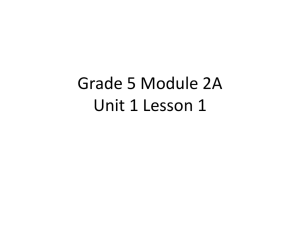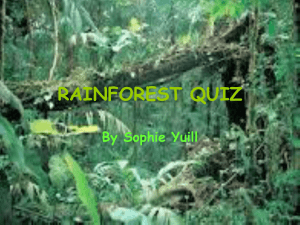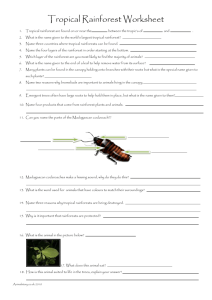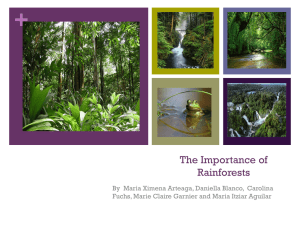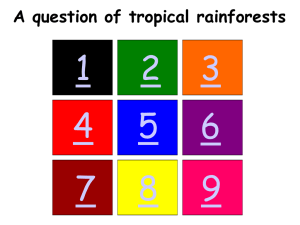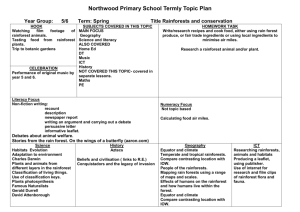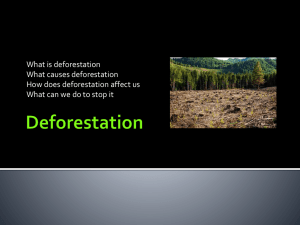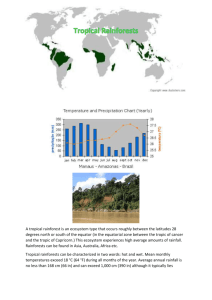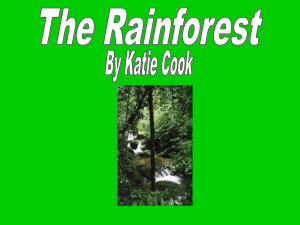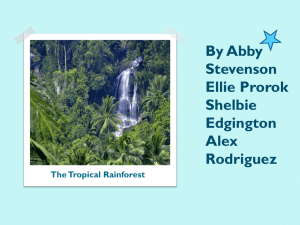Match the word with the correct definition and find the Slovene
advertisement
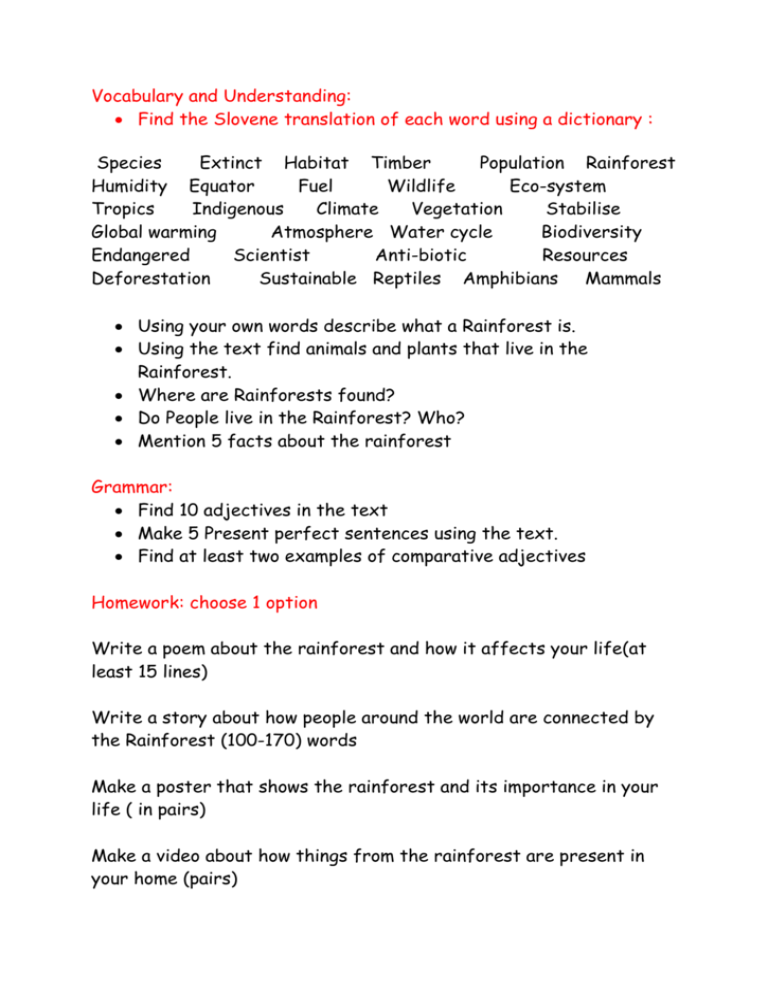
Vocabulary and Understanding: Find the Slovene translation of each word using a dictionary : Species Extinct Habitat Timber Population Rainforest Humidity Equator Fuel Wildlife Eco-system Tropics Indigenous Climate Vegetation Stabilise Global warming Atmosphere Water cycle Biodiversity Endangered Scientist Anti-biotic Resources Deforestation Sustainable Reptiles Amphibians Mammals Using your own words describe what a Rainforest is. Using the text find animals and plants that live in the Rainforest. Where are Rainforests found? Do People live in the Rainforest? Who? Mention 5 facts about the rainforest Grammar: Find 10 adjectives in the text Make 5 Present perfect sentences using the text. Find at least two examples of comparative adjectives Homework: choose 1 option Write a poem about the rainforest and how it affects your life(at least 15 lines) Write a story about how people around the world are connected by the Rainforest (100-170) words Make a poster that shows the rainforest and its importance in your life ( in pairs) Make a video about how things from the rainforest are present in your home (pairs) WHAT ARE TROPICAL RAINFORESTS? Tropical rainforests are very dense, warm, wet forests. They are abundant with many species of wildlife and vegetation. Today rainforests cover about 6% of the Earth’s land surface. They are the habitat to some 50-70% of all life forms on our planet. Rainforests contain the most productive and the most complex ecosystems on earth. The plants of the rainforests generate and contribute to the Earth’s oxygen. These plants are also useful to people in that they can be used in new drugs that may cure many of the world’s deadly diseases. WHERE ARE RAINFORESTS LOCATED? Rainforests lie in the tropics, mostly in the area between the Tropic of Cancer (23.5◦ N Latitude) and the Tropic of Capricorn (23.5◦ S latitude). This band covers an area about 4800 km wide. Due to their location, rainforests receive a lot of sunlight and an abundance of rainfall, about 400 to 1000 cm of rain each year. This creates the ideal conditions for rapid vegetation growth. The wide range of plants encourages a huge variety of insects, birds and animals. The largest rainforests are found in: 1. Brazil (South America) 2. Congo Basin (Central Africa) 3. Indonesia (Southeast Asia) 4. In Hawaii. Madagascar 5. Australia WHY PROTECT RAINFORESTS? Preserving rainforests is of enormous benefit to humankind. Rainforests are: home to 50 million indigenous peoples, a habitat for millions of species of plants and animals, stabilising the world’s climate, a source of medicines and foods, and a source of other forest products STABILISE THE CLIMATE Rainforests stabilise the world’s climate by absorbing carbon dioxide from the atmosphere. The high levels of carbon dioxide in the atmosphere are responsible for global warming. Destroying rainforests is the second largest cause of global warming. So as more and more trees are cut down and burnt, the level of carbon dioxide in the atmosphere increases and contributes to the ”green house effect”. Rainforests also help maintain the water cycle. Through evapotranspiration, plants release water into the atmosphere, important for cloud formation. As vegetation is reduced, so there is little evapo-transpiration and therefore less water is released into the atmosphere for recycling as rain. This can result in drier conditions in the areas affected. HABITAT FOR PLANTS AND ANIMALS Tropical rainforests are known for their rich biodiversity. This means that they have a far greater number of different species of plants and animals than other natural habitats. Of the estimated 30 million species, there is the fear that up to 50,000 species a year could become extinct through rainforest destruction. Endangered species include mountain gorillas, chimpanzees, bonobos, giant anteaters, hyacinth macaws, giant otters, the giant Amazon River turtle, the Philippine eagle and jaguar. Many species currently found in tropical rainforests have not yet been studied by scientists. It is quite likely that many of them are of medical, as well as of economic value, to humankind. Such is the case of a species of wild maize, recently discovered in the forests of south central Mexico. Its habitat was threatened with destruction by small farmers and commercial loggers. This wild maize offers resistance to four diseases which cause at least 1% loss to the world’s maize harvest each year, worth more than $500 million. SOURCE OF MEDICINES Tropical forest species contribute to our health needs. On average, one out of four medicines available on prescription – whether antibiotic, tranquilliser, laxative, or contraceptive pills, owes its origin to ingredients found in tropical rainforest plant species. Drugs obtained from rainforest plants are used to treat a number of dangerous diseases, such as cancer, malaria, heart disease, bronchitis, dysentery and tuberculosis. Some examples are: A drug which is obtained from the Rosy Periwinkle, a plant which only grows in the rainforest of Madagascar, is used to treat certain forms of leukaemia; The bark of Cinchona trees is used in the treatment of malaria; SOURCE OF FOODS Many products that we consume at home come from the rainforests. These include: Spices (black pepper, cardamom, chilli, cinnamon, clove, ginger, nutmeg and vanilla) Nuts (Brazil nuts, macadamia, cashew and peanuts) Fruits and vegetables (avocadoes, papayas, limes, mangoes, passion fruit, pineapples, guavas, grapefruit, coconut and sweet potatoes Non-timber products Aside from foods and medicines, tropical rainforests are also rich in non-timber products such as bamboo and natural fibers which are used in the production of furniture, floor coverings, baskets, bags, rope and clothing. Non-timber forest products provide a wealth of resources for both rural and urban dwellers in rainforest areas. Wood products Hardwoods from the rainforests, such as teak, mahogany and rosewood are used for many purposes. These range from furniture, window sills, doorframes, flooring, toys and kitchen utensils. As logging remains one of the major causes of deforestation, consumers should ensure that the timber they use comes from sustainably managed sources and not rainforests. 13 Facts about the rainforest 1. Rainforests once covered 14% of the earth’s land surface; now they cover about 6%. 2. The largest area of rainforest in the world is found in South America (45%), followed by Africa (30%), Southeast Asia (16%), and Australia (9%). 3. The Congo Basin contains the second largest rainforest on the planet after the Amazon. 4. Rainforests produce about 40% of the world’s oxygen. 5. 50 acres of rainforest are lost every minute. 6. Around 150,000 sq km of the tropical rainforest, equivalent to the size of England and Wales, is destroyed every year. 7. In the 19 years since it’s founding in 1989, the Rainforest Foundation has protected 116,485,000 square km. PEOPLE 8. As many as 500 million people in tropical rainforests depend directly or indirectly on the forests for wild food resources, fresh water, building materials and natural medicines. 9. 50 million have their homes in the rainforest. 10. 80% of the world’s poorest people depend on the rainforest. NATURE 11. Rainforests contain about two-thirds of the world’s wildlife species. 12. 50,000 wildlife species a year become extinct because of rainforest destruction. 13. Tropical rainforests are the Earth’s oldest ecosystems. Within a four mile square area of a tropical rainforest, you would find: a. Over 750 species of trees b. 1500 different kinds of flowering plants c. 125 species of mammals d. 400 species of birds e. 100 reptiles f. 60 amphibians g. Countless insects h. 150 species of butterflies
